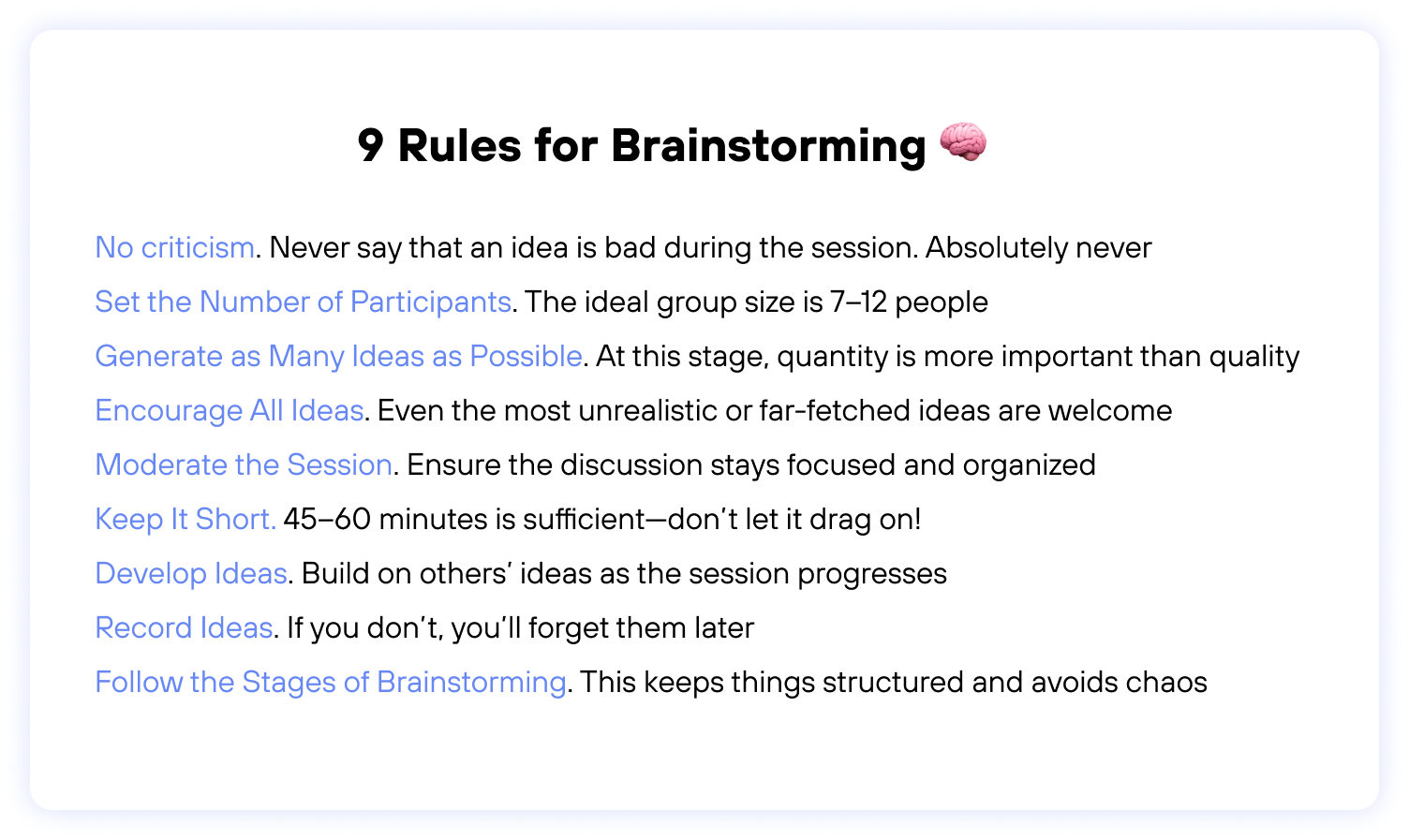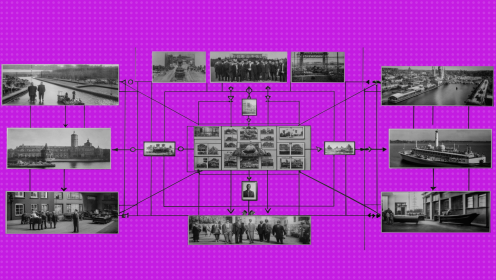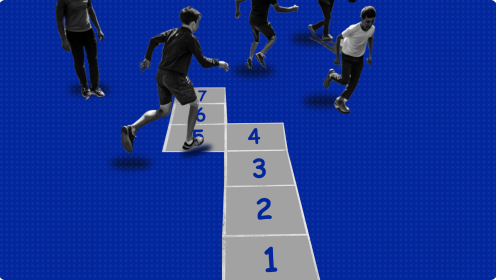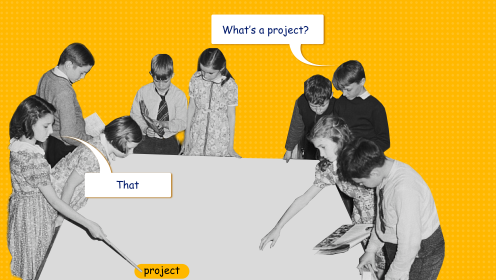What is Brainstorming
📌 Brainstorming (or «brain attack») is a collaborative method for generating ideas and solving problems related to a specific issue.
This technique helps uncover the best, most unconventional, and unexpected solutions to challenges. To succeed, participants need to set aside doubts, embrace their creativity, and express even the most outlandish ideas. By evaluating, refining, and enhancing these ideas, the team can tackle any problem.
Like any other method, brainstorming comes with both advantages and disadvantages.
Advantages:
- It can uncover truly unique solutions
- All team members, including juniors, participate, ensuring a collective decision
- It requires little time — often completed in just a couple of hours
- Offers a thorough approach to the problem
- The method is straightforward and easy to implement
Disadvantages:
- There’s no guarantee that a solution will be reached
- It can become chaotic and disorganized
- Strict adherence to rules is necessary to manage the chaos and maintain focus
The rules of this method were also developed by Alex Osborn. Let’s take a closer look at them👇
Brainstorming Rules
No criticism
Everyone taking part in the brainstorming session should be allowed to speak. Criticism of others' ideas is prohibited — even if an idea seems odd or unfeasible at first. Later, the team can refine the idea, merge it with another, or develop a new, more practical version.
Additionally, many people fear criticism, especially from their superiors. Without criticism, there is no fear or hesitation. When there’s no fear, creativity can flourish.
Lastly, criticism disrupts the flow of ideas. While feedback is being given, others may lose their inspiration and forget their thoughts.
Quantity Over Quality
In a brainstorming session, the objective is to generate as many ideas as possible — whether big, small, wild, trivial, boring, original, unconventional, fun, or ambitious. During the evaluation and analysis stage, these ideas can evolve into something bigger, more feasible, and capable of solving the problem.
Encourage Even the Most Outlandish Ideas
An idea may seem wild and unrealistic, but it can inspire others — driving creativity, sparking smiles, and uniting the team.
Modernize and Improve
This is the core purpose of the brainstorming session. Listen to your colleagues, get inspired by their ideas, and build upon them. Share your own solutions. That’s what brainstorming is all about.
Don’t Drag Out the Brainstorming
Setting a clear time limit is essential. The ideal session length is 45–60 minutes. Initially, you’ll generate basic and obvious ideas, but as the session progresses, the real creative flow will kick in.
Don’t Forget the Moderator
To maintain structure and keep the discussion on track, a moderator is necessary. They should be well-versed in the topic, familiar with the team (to manage overly enthusiastic participants and engage the quieter ones), steer the conversation in the right direction, and monitor the time.
Record Ideas Immediately
When the ideas are flowing and the team is inspired, it’s vital to capture everything for future analysis and refinement. Assigning this task to one person ahead of time is a good strategy. This person can take notes by hand, use a voice recorder, or even record video — whatever format works best.
Determine the Number of Participants
An important factor: too few or too many participants can lead to unclear results or even no results at all.
Fewer than seven participants may not generate enough ideas. On the other hand, with more than 12 participants, the more vocal individuals may dominate, leaving others passive. The optimal number is between 7 and 12 participants.
Follow the Stages of Brainstorming
To achieve meaningful results, it's essential to follow a structured process. This helps prevent chaos and confusion. We’ll outline the stages in more detail below.

Key Stages of Brainstorming
Preparation
The brainstorming organizer defines the problem, selects the team, arranges the venue, and sets the time and boundaries. They also assign a moderator and handle the technical aspects. It's beneficial to inform participants about the topic in advance so they can start thinking about it. By the time the session begins, participants may already have a few ideas.
Defining the Task
Once the topic is set, the task needs to be clearly defined. What is the problem? What do we want to achieve by solving it? The organizer (often the project manager) and the moderator address these questions and share the key points with the participants.
Warm-up
If the brainstorming session isn’t the first one and participants are already familiar with each other, the warm-up may be skipped. However, it remains an important step to get everyone into the right mindset for communication and idea generation. Special exercises can be used to facilitate this process.
Here are a few examples of warm-up exercises:
- «Portrait» Game. Prepare 100 cards with various images. Each participant chooses the one that best represents them and explains why. This game helps people relax and get to know each other better.
- «Keychain Connection» Game. Participants take out their keys and explain what each one is for. It's a simple yet effective game that creates a relaxed atmosphere and sets the right tone. Instead of keys, you can use other personal items, such as a cardholder.
Idea Generation
The next stage is the core of the brainstorming process. The success of this stage depends on the moderator: they must prevent criticism, guide the conversation in the right direction, and ensure everyone in the group participates. The secretary (the person recording ideas) plays the most active role at this stage.
Evaluation, Selection, and Analysis of Ideas
The final stage is the evaluation phase. The moderator, the meeting organizer, and all participants collaborate to determine which ideas are viable for implementation. If there are many ideas, they can be grouped into categories based on theme, complexity, or other criteria.
Five Brainstorming Techniques
There are various ways to structure the idea generation process. Alex Osborn's classic method has been refined, adapted, and enhanced over the years, leading to the development of different brainstorming techniques.
Technique 1. The 6-3-5 Method
This method is ideal for smaller teams that couldn’t gather seven people for the brainstorming session. Six participants have five minutes to write down three ideas for solving the problem. They then exchange their papers, build on each other's ideas, and exchange again before discussing the results. This quick method works well for teams that are already familiar with working together.
Technique 2. Reverse Brainstorming
This technique is particularly useful for experienced teams tired of traditional brainstorming. In reverse brainstorming, the focus is on the negative aspects of the product or service — think about how the product could fail or how clients could be lost. Then, based on these problems, the team works on finding solutions.
Technique 3. The Ladder Method
This method works well for teams of any size. The process starts with the entire team discussing the problem together. Then, two people remain in the room to share their ideas for a few minutes. A third person joins, offers their own solutions, and the first two share theirs. This continues, with each new participant contributing ideas, until everyone has had a chance to speak.
Technique 4. Role Play Brainstorming
This fun yet effective technique helps teams think creatively. It’s like a game that encourages participants to step outside their usual perspectives. Each team member adopts the persona of a well-known figure — such as Elon Musk, Queen Elizabeth, or Fyodor Dostoevsky — and generates ideas based on how they imagine that person would approach the problem. The goal is to think about how these figures might tackle the issue at hand.
Technique 5. Shadow Brainstorming
This technique is ideal for teams with more than 10–12 people. The group is divided into three teams.
The first group consists of the most vocal members, who present their ideas openly. The second group is the «shadow» team. They listen to the first group, take notes, and analyze the ideas. The third group consists of the evaluators, who review both the ideas presented by the first group and those analyzed by the second group, discussing them and providing a final judgment.
This method is particularly useful for teams with diverse dynamics, such as those with dominant speakers and quieter members who prefer brainstorming in a more private setting.
Possible Mistakes During Brainstorming. Tips from WEEEK
The Organizer (or Moderator) Fails to Control the Process
Without control, chaos takes over — everyone speaks at once, interrupting each other. As a result, no new ideas are generated, and participants become tired of the noise and confusion.
💡 What to Do? Select an experienced and respected moderator who understands the topic and knows the team well. Clearly outline their responsibilities and stress the importance of maintaining order during the session.
Unrelated Employees Participate in the Discussion
Alternatively, too many similar employees may participate, which can lead to wasted time.
The ideal participants should be diverse yet relevant to the topic. For example, a product brainstorming session should include a marketer, a copywriter, a producer, and a creative professional — anyone involved with the product at different stages, not just developers and product managers.
💡 What to Do? Don’t gather the entire team just for the sake of numbers, but ensure you include everyone who is directly connected to the issue, even if they’re involved at different stages.
Too Few or Too Many People
This issue is similar to the previous one, but it’s about the quantity. Less than 6–7 participants is too few for a brainstorming session, and you may not generate enough ideas. More than 12 participants is too many, risking a disorganized and prolonged meeting.
💡 What to Do? Limit the number of participants: a minimum of 7, a maximum of 12. Too many people? Invite them to the next session.
Excessive Adherence to Hierarchy
The moderator gives priority to those in higher positions, causing others to feel suppressed by authority and hesitant to share their ideas. This approach stifles clear thinking and open communication within the team.
💡 What to Do? Start with participants in lower positions. When they speak first, they will be less afraid to contradict leadership and share their thoughts freely.
Not All Ideas Are Recorded
The brainstorming session may have been productive, but if no ideas are recorded, nothing tangible will come out of it. This is a simple yet common mistake.
💡 What to Do? Assign a secretary to take notes during the session to ensure all ideas are captured.
All Employees Are Remote, and Brainstorming Seems Impossible
New times bring new rules. Don’t worry — brainstorming can still be successfully organized for remote teams. There’s no need for everyone to gather in one room; technology allows everything to be done online.
💡 What to Do?
- Clearly define the date, time, and agenda. If the brainstorming is planned «after lunch» you may never get everyone together, as lunchtime can vary in remote settings.
- Prepare online materials for the meeting, such as the rules for brainstorming, a virtual board with goals and tasks, and name tags for participants. This will help everyone participate more effectively.
- Be prepared for internet delays and connectivity issues. Record the meeting and visually capture ideas so that anyone who gets disconnected can quickly rejoin the discussion.
Don’t Overload Your Brain — The Essentials
- Brainstorming is a safe space for generating ideas. To ensure a productive session, follow these guidelines: avoid criticizing even the most unconventional ideas, encourage as many ideas as possible, moderate the discussion, take notes, and keep the meeting brief.
- The ideal number of participants is between 7 and 12, but if there are more, consider using a specific brainstorming technique (such as «Shadow Brainstorming»).
- Start by gathering ideas from junior employees, then move up the organizational hierarchy.
- Creative games can be an effective way to kickstart the session and help participants switch into a creative mindset.
















